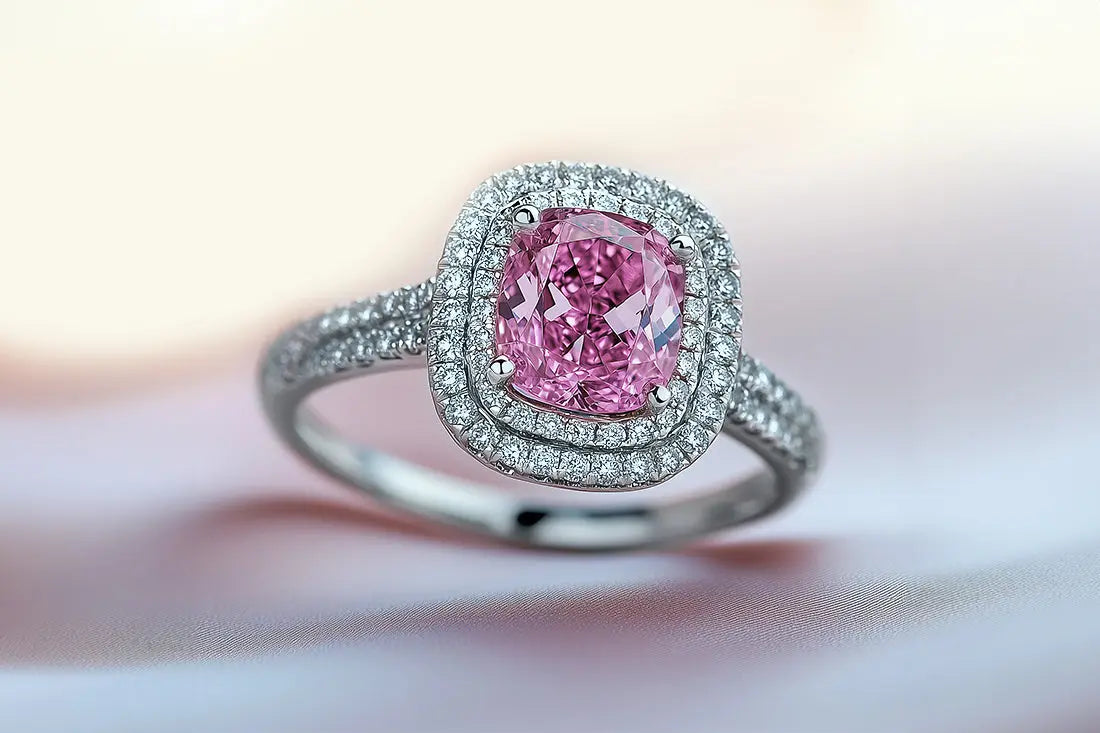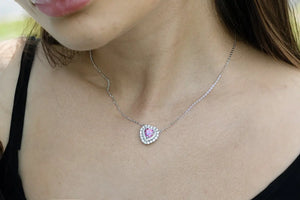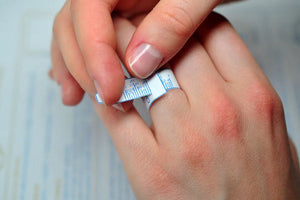Moissanite has become an increasingly popular alternative to traditional diamonds, especially for those seeking both beauty and affordability. Known for its exceptional sparkle and durability, moissanite is a top choice for eco-conscious shoppers and those who appreciate its unique charm. While moissanite has similarities to diamonds, it also has distinct characteristics that shine through when we consider the “4Cs”: Cut, Colour, Clarity, and Carat.
These 4Cs are key to understanding gemstone quality and can help you select a moissanite that fits both your personal taste and budget. According to a recent study by the Gemological Institute of America (GIA), approximately 70% of shoppers prefer gems with a colourless or near-colourless look. Qualities moissanite offers at a fraction of the cost of diamonds.
In this guide, we’ll walk you through each of the 4Cs, exploring how they impact moissanite quality and price, so you can make a confident and informed choice.
The 4Cs of Moissanite Quality
The 4Cs—Cut, Colour, Clarity, and Carat are widely recognised as essential factors in assessing gemstone quality. Though moissanite and diamonds are evaluated using these same factors, the unique properties of moissanite make its evaluation slightly different.
Here’s a closer look at each aspect:
1. Cut
Cut is what determines how light reflects off a gemstone’s surface, which gives moissanite its signature sparkle. With its high refractive index, moissanite often has a noticeable brilliance that can even outshine a diamond. Common cuts include round, princess, and cushion, each with its own appeal and price point.
Top Cuts for Brilliance
The round brilliant cut is a popular choice for those who want maximum sparkle, as it’s designed to reflect light brilliantly. However, if you prefer a more unique shape, cushion or princess cuts also offer plenty of sparkle and can be more affordable.
How Cut Impacts Price
The price of moissanite varies depending on the cut, as some shapes require more craftsmanship. Round cuts, for example, are usually priced higher due to the precision needed to perfect their light reflection. Cuts like cushion or princess are often more budget-friendly but still deliver a stunning look.
2. Colour
Moissanite is graded on a colour scale similar to diamonds, ranging from colourless to shades with a slight tint. Most shoppers prefer stones that fall in the "D" to "F" range, which resemble the icy white colour of high-quality diamonds.
Here’s a quick reference for moissanite colour grading:
|
Moissanite Colour Grading |
Description |
|
D |
Absolutely colourless, icy white |
|
E |
Nearly colourless, with minor traces visible under magnification |
|
F |
Slight traces of colour under magnification |
|
G |
Near-colourless, subtle colour detectable |
|
H-I |
Near-colourless, light tint visible |
|
J-Z |
Noticeable colour, often yellow or brown tints |
3. Clarity
Most moissanites are lab-grown, meaning they generally have very few visible inclusions or blemishes. This gives them an advantage over natural stones that often have small imperfections. Moissanites are usually graded in the VS (Very Slightly Included) to IF (Internally Flawless) range, meaning that any inclusions are tiny and typically invisible without magnification.
Clarity’s Role in Price
Higher clarity grades, such as IF or VVS, can add some value, but overall, clarity doesn’t have a huge impact on moissanite prices. Moissanite’s high clarity is a natural result of its controlled creation process, so even slightly included stones still look brilliant to the unaided eye.
4. Carat
Carat refers to the weight of a gemstone, which often influences its perceived size. Because moissanite is slightly less dense than diamond, a 1-carat moissanite will appear slightly larger than a 1-carat diamond, offering more visual impact for the price.
Popular Carat Sizes
In the UK, many buyers choose moissanite sizes in the 1 to 2-carat range, which provides a noticeable presence without becoming cost-prohibitive. Larger carats come with a higher price, but moissanite’s affordability allows buyers to opt for larger sizes without the significant price increase seen with diamonds.
How the 4Cs Affect Moissanite’s Quality and Price
Each of the 4Cs uniquely influences both the appearance and price of moissanite. Here’s a brief overview:
Cut: Quality of the cut is critical for sparkle, with round and princess cuts usually being pricier due to their brilliance.
Colour: Colourless (D-F) moissanites resemble top-grade diamonds and are often more popular, though near-colourless options are a great way to save without losing appeal.
Clarity: Clarity affects beauty but doesn’t impact price as dramatically, since most moissanites already have high clarity.
Carat: Larger carat sizes increase the cost, but compared to diamonds, moissanite provides a great value in larger sizes.
Understanding these basics allows you to make choices that align with your priorities. For instance, if you prefer maximum sparkle, focus on a high-quality cut. If size is your main goal, a lower colour grade may be an option to help balance cost.
Practical Tips for Buying Moissanite
Here are some helpful tips to consider as you shop for moissanite:
Set a Budget and Focus on the Essentials
Decide which of the 4Cs is most important for you. If sparkle is your priority, look for a high-quality cut. If you’re aiming for a larger size, choosing a slightly lower colour grade can help you get a bigger stone within your budget.
Check for Certification
Trusted sellers provide certificates that confirm a gemstone’s quality. Certification offers peace of mind that you’re getting exactly what you’re paying for.
Buy from Reputable Retailers
A respected jeweller can make all the difference. Leading sellers in the UK specialise in lab-grown gems and provide guarantees on authenticity, ensuring you get a genuine, high-quality moissanite.
Ethical and Sustainable Benefits of Moissanite
One of moissanite’s biggest appeals is its ethical value. Lab-grown moissanite avoids the environmental impact and ethical issues tied to diamond mining. Many UK buyers are prioritising sustainability in their purchases, and moissanite fits this trend perfectly, offering beauty without compromise.
Frequently Asked Questions (FAQs)
What is the best colour grade for moissanite?
Colourless (D-F) grades are considered ideal as they closely resemble high-quality diamonds. Near-colourless (G-H) grades are also popular, balancing beauty and price.
Does moissanite’s clarity affect its sparkle?
Clarity contributes to sparkle, but cut has the biggest influence on brilliance. Choosing a well-cut stone maximises sparkle.
Is moissanite graded the same way as diamonds?
Yes, moissanite is assessed using the same 4Cs—Cut, Colour, Clarity, and Carat. However, grading standards can differ slightly due to moissanite’s unique qualities.
What carat size is recommended for moissanite rings?
Common choices for moissanite rings are between 1 and 2 carats, but size depends on personal preference and budget. Moissanite’s affordability makes larger stones more accessible.
How well does moissanite retain its value?
While it may not hold value like natural diamonds, moissanite is highly valued for its beauty and affordability, making it a meaningful choice for personal jewellery.
Conclusion
Moissanite is an excellent choice for those seeking a beautiful, durable, and ethical gemstone. Understanding how the 4Cs—Cut, Colour, Clarity, and Carat—affect moissanite quality and price allows you to select a stone that matches your taste and budget. With its versatility and eco-friendly appeal, moissanite is perfectly suited for today’s jewellery trends in the UK.



